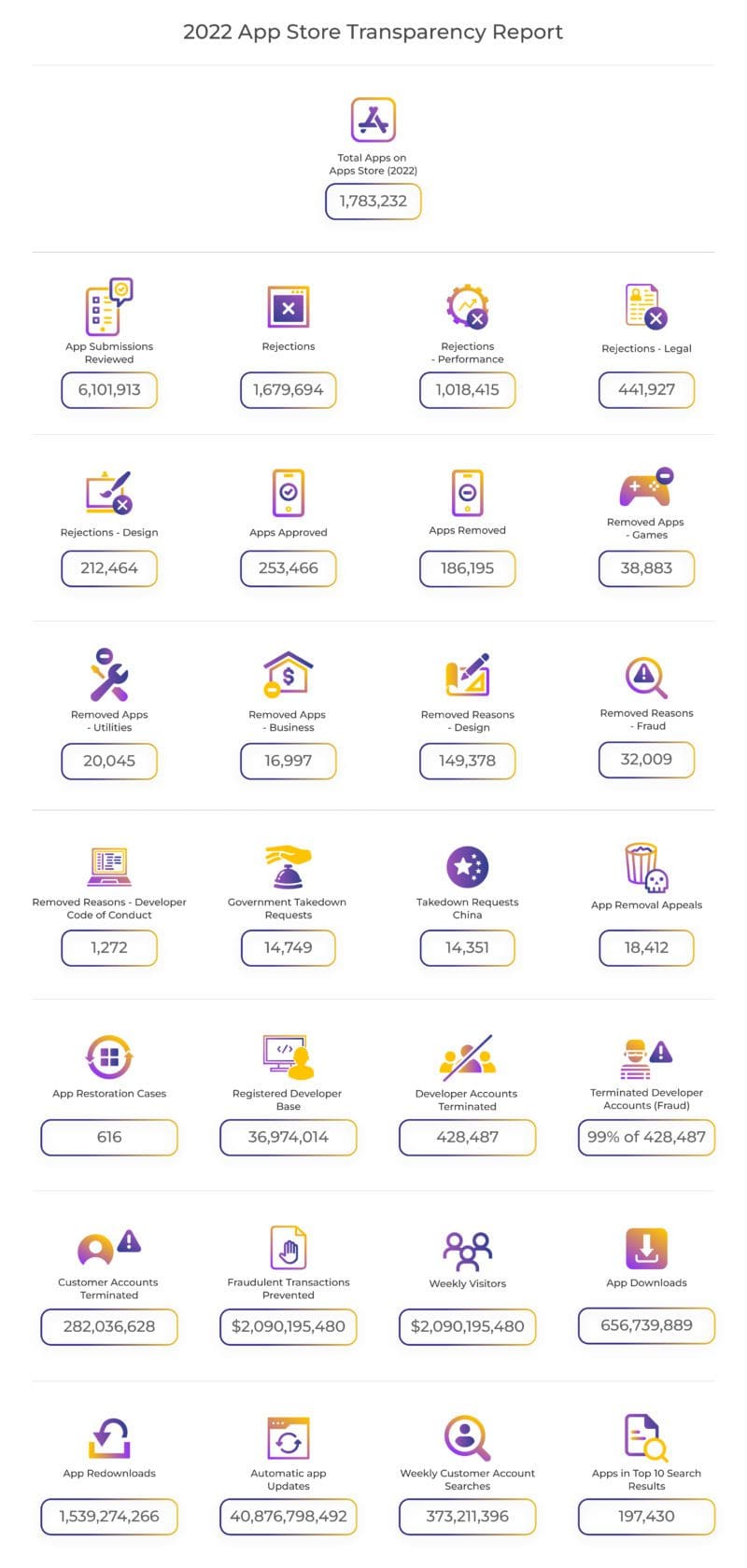Apple’s App Store has been a pioneer in the app distribution market since its inception in 2008. The 2022 App Store Transparency Report sheds light on the operations, performance, and safety measures of the App Store. This article will analyze the data presented in the report and make projections for the future, particularly concerning mobile advertising. 
Table of Contents
A Snapshot of the App Store in 2022
- As of 2022, the App Store boasts 1,783,232 apps. Throughout the year, Apple reviewed 6,101,913 app submissions, rejecting 1,679,694 of them.
- The majority of rejections fell under ‘Performance‘ (1,018,415), followed by ‘Legal‘ (441,972), and ‘Design‘ (212,464).
- 253,466 apps were approved, while 186,195 apps were removed from the App Store.
- The top categories for removed apps were Games (38,883), Utilities (20,045), and Business (16,997).
- The most cited reasons for removal included Design (149,378), Fraud (32,009), and Developer Code of Conduct (1,272).
- The App Store received 14749 government takedown demands, with the majority coming from China (14,351).
- Appeals for app removals numbered 18,412, with 616 restorations.
- Apple’s registered developer base stood at 36,974,015, with 428,487 accounts terminated (99% predominantly for fraud).
- For customers, there were 282,036,628 terminated accounts and $2,090,195,480 worth of fraudulent transactions were prevented.
- The App Store received an average of 656,739,889 weekly visitors, with 747,873,877 app downloads, 1,539,274,266 app re-downloads, and 40,876,798,492 automatic app updates.
- Search statistics showed that an average of 373,211,396 customer accounts searched the App Store weekly, with 197,430 apps appearing in the top 10 results of at least 1000 searches.
Projections and Implications for Mobile Advertising
This data reflects Apple’s commitment to a secure and quality-controlled app ecosystem. The high number of rejections and terminations signifies strict adherence to guidelines. This trend is likely to continue, ensuring a safe environment for users.
We can also foresee an increasing number of app submissions and downloads. With a large base of 36,974,015 developers, innovation and competition will drive the growth of apps. This presents an opportunity for advertisers to reach a wider audience through in-app advertising.
However, the stringent review process means that advertisers need to be mindful of compliance with Apple’s guidelines, especially regarding performance, design, and legal aspects. This can be challenging but is crucial for sustained presence in the App Store.
Furthermore, the dominance of Games, Utilities, and Business categories indicates that these sectors remain popular among users. Advertisers should thus focus on these categories for targeted advertising.
Lastly, the significant number of weekly searches (373,211,396) signifies the importance of App Store Optimization (ASO) for visibility. Advertisers must optimize app listings to appear in top search results, ensuring higher discoverability and potentially more downloads.
Conclusion
Apple’s App Store continues to be a mammoth in the app distribution market. The 2022 transparency report reveals a stringent but growing ecosystem. For mobile advertisers, this presents both challenges and opportunities. Adherence to Apple’s guidelines, focusing on popular categories, and optimizing for search are critical steps in leveraging the App Store for mobile advertising. As the App Store evolves, advertisers must remain agile and adapt to the changing landscape to ensure that their advertising strategies are effective and compliant with Apple’s standards.
In the long term, mobile advertisers should also keep an eye on emerging trends and categories. As the app market matures, new categories may rise to prominence, and advertising strategies should be versatile enough to capitalize on these opportunities.
Moreover, advertisers should be vigilant about the international aspects of the App Store, especially considering the varying regulations and takedown demands in different countries. China, for instance, has shown a significant number of government takedown demands. This implies that advertisers targeting international markets should be well-informed about local regulations and tailor their content accordingly to avoid potential hurdles.
Additionally, with the value of fraudulent transactions prevented being over $2 billion, it is evident that security and fraud prevention are paramount for Apple. Advertisers should ensure that their practices are transparent and secure to build trust with both Apple and the users.
Now the real conclusion
Apple’s App Store presents a vast and fertile ground for mobile advertisers. However, success in this arena requires a well-thought-out strategy that not only focuses on reaching a broad audience but also on compliance, optimization, targeting popular and emerging categories, and understanding the global landscape.
By doing so, advertisers can effectively utilize the App Store as a platform for reaching their target audience and achieving their marketing goals while contributing positively to the rich and secure ecosystem that Apple strives to maintain.





